Acne has long ceased to be the exclusive domain of teenagers. Now they are a scourge for adults, and even for very young children. The beautiful half of humanity reacts especially sharply to their appearance. Ladies try in every possible way to hide this defect in their skin, covering it with a thick layer of foundation. However, acne is not just a banal skin defect. Very often, a scattering of acne on the face is the result of dysfunction of certain systems. And sometimes they signal a serious illness. Let's look at which organs are responsible for acne on the face.

general information
According to eastern medical practice, any defect that appears on the face is a reflection of internal pathologies. This means that, experiencing malfunctions, any organ signals this to its owner, causing inflammation in a certain area. But how do you know which system is failing? To do this, you need to figure out which organs are responsible for acne on the face.
To determine which system of the body sends “sos signals”, a special “acne map” was developed.
In it, the entire face is divided into zones:
Let's study each zone in detail to understand which organs are responsible for acne on the face. The photo below allows you to see how the areas are demarcated.
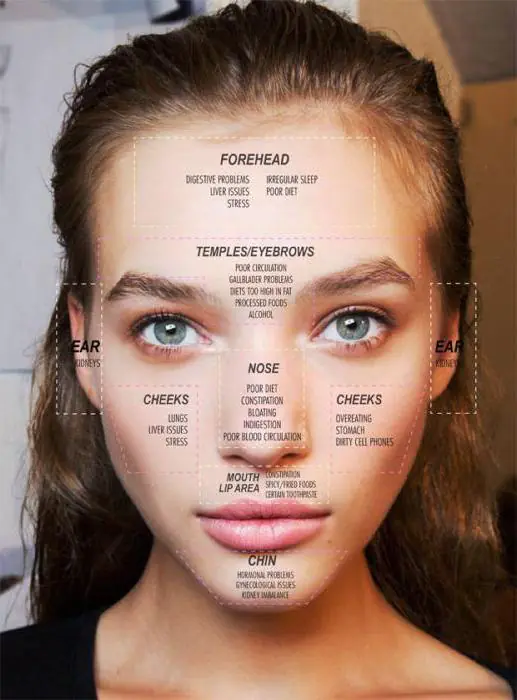
Forehead area
If acne on the face appears in this particular area, what organs are they responsible for? The appearance of a rash in this area indicates a disruption of the gastrointestinal tract.
However, due to its rather extensive territory, the forehead is further divided into several microzones:
- Along the hairline. Here, as a rule, acne takes root, signaling a person about problems with the gallbladder and bile ducts.
- Above the eyebrows. This arrangement of inflammatory elements is the result of a malfunction of the stomach itself, as well as the pancreas.
- On the eyebrows and in the center of the forehead. This area is reserved for eels, whose task is to warn their “master” about intestinal disorders.
This division of the forehead into small zones allows you to better understand the causes of the rash.
Sometimes you can see acne on the face in children. Which organs are responsible for rashes on the child’s forehead? Such rashes also indicate an imbalance in the digestive tract. However, the source of the problem is most often an allergy to any foods, incorrectly selected medications and vitamins.
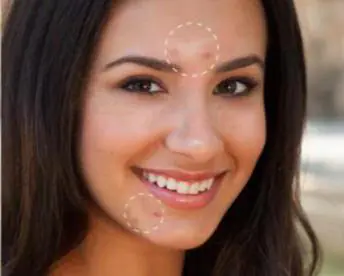
Nose bridge area
Pimples, the habitat of which is this area, are a consequence of liver dysfunction. Most often, such disorders are associated with too frequent abuse of alcoholic beverages. A rash on the bridge of the nose may indicate an addiction to foods rich in animal and vegetable fats. However, this aspect only applies to adults.
In children, inflammation in this area indicates the presence of excess dairy products in the diet.
Skin around the eyes
What organs are responsible for acne on the face in this area? A scattering of acne, rashes and wen in the area around the eyes, the formation of bags, barley - all these are signs of a malfunction of the kidneys and adrenal glands.
Such manifestations may indicate severe dehydration. This is typical for people who do not drink enough clean water.
Nose area
This area for acne is the most common habitat. After all, it is on the nose that these unfortunate bright red tubercles most often pop up, mercilessly spoiling the entire appearance.
At the same time, it is impossible to unambiguously answer the question of why such acne forms on the face, what organs are responsible for, and how to treat them.
The cause of inflammation specifically in this area can be any disorder:
- hormonal imbalance;
- increased secretion of the sebaceous glands;
- problems with the cardiovascular system.
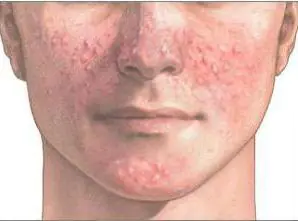
Ear area
Most often, several unpleasant pimples appear on the lobe. Acne often attacks the area behind the ear.
In this case, the kidneys and adrenal glands make themselves known again. Moreover, inflammation in the ear is somewhat more dangerous than on the skin around the eyes. In this area, there is a high probability of an ordinary pimple developing into a boil.
Cheek area
It turns out that blush not only makes your face look healthy. It is proof that a person has clean and perfectly functioning lungs. Have you already guessed which organs are responsible for acne on the face in the cheek area? Of course, they signal problems in the respiratory system. We are mainly talking about the lungs.
Small rashes in the cheek area most often indicate a clogged respiratory system. Such violations can be caused by general environmental pollution, or an extremely bad habit - smoking.
Lip area
Acne and small pimples localized in the mouth area eloquently indicate disturbances in the functioning of the nervous system and hormonal levels.
This can be caused by many factors:
- prolonged depression;
- stress;
- nervous breakdown;
- stopping taking oral contraceptives (which causes hormonal imbalance).
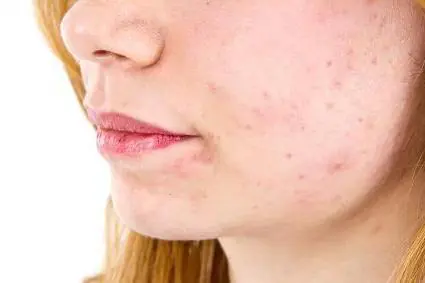
Chin area
If the ill-fated red “friend” crawled out in this area, then you can safely go to the endocrinologist. This applies to both women and men. The occurrence of acne in this area is usually the result of disruption of the reproductive system and endocrine glands. It is important to remember, if such pimples often form on the face, which organs are responsible for them. In men, they are often a symptom of developing prostatitis.
But with kids it’s not so serious. The appearance of inflammation is usually associated with uncontrolled salivation by the child. Only time can correct this. But you can prevent the appearance of new pimples if you carefully monitor your child and wipe his drool in a timely manner.
How to get rid of the problem?
Is it possible to fight various rashes? Of course yes. You just need to know, if acne often occurs on the face, which organs are responsible for it. Medicines and pills aimed only at eliminating an aesthetic problem, in most cases, bring only temporary relief. No matter how much effort, time and money you invest in going to cosmetologists and all the care products they recommend, none of this will give a lasting, long-lasting result. After all, it is the diseased organ that needs to be treated, and not the symptoms provoked by it.
The problem of getting rid of skin inflammation must be taken extremely seriously. Treatment, first of all, should be carried out comprehensively. Both external and internal therapy are necessary. But the main attention, of course, should be paid to eliminating malfunctions in the functioning of organs that send “sucking signals” in the form of acne on the face.
It is, of course, better to entrust your treatment to specialists in this field: dermatologists. They will find the true causes of acne. It wouldn’t hurt to pay a visit to specialized specialists, taking into account the “acne map” described above.
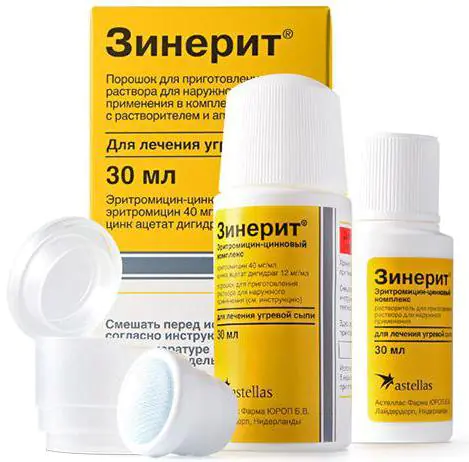
Only doctors are able to select an effective course of medications that is necessary for a particular person.
Drug therapy
But what to do if unpleasant pimples are too annoying? What can you do to achieve perfectly smooth facial skin? There are some medications that can help “sufferers.” However, you should realize that this is a temporary relief if you do not take into account: why acne constantly appears on the face, what organs are responsible for.
Medicines that can help in the fight against unpleasant defects:
- Antibiotics. Preparations containing doxycycline are suitable for internal use. Local medications based on erythromycin or clindamycin will be beneficial.
- Antiseptics. These products destroy harmful microorganisms that cause acne and pimples. The following medications are excellent antiseptics: “Zinerit”, “Baziron”, “Zinc ointment” and “Synthomycin ointment”.
- Hormonal drugs. These medications are designed to correct hormonal imbalances. They restore the necessary levels of androgen and estrogen in the body. It is extremely dangerous to resort to these remedies without consulting a doctor. These drugs can be beneficial only when they are chosen correctly. Otherwise, they cause serious harm to the body.
- Retinoids. These are medications that are derivatives of vitamin A. Such a medicine is the drug “Differin”. It is produced in the form of a cream and also a gel.
- Products based on azelaic acid. Such preparations have a strong antibacterial effect and at the same time have the most gentle effect on the facial skin itself. Representative: medicine "Skinoren". Release form: gel or cream.
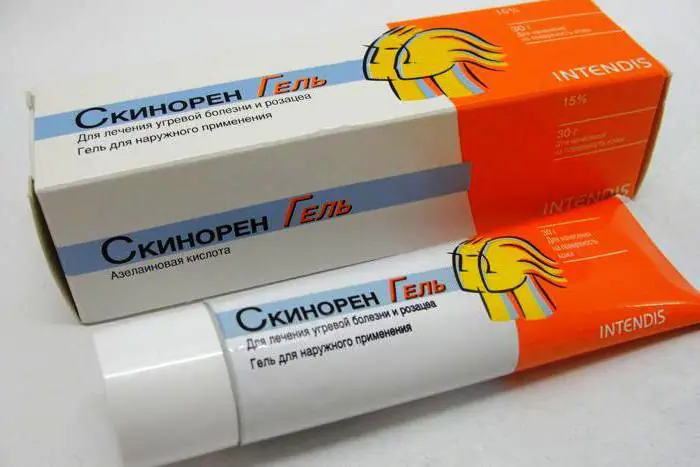
By determining exactly which organs are responsible for acne on the face (the photo will help you correctly delineate the zones), you can promptly pay attention to your health. And, perhaps, prevent the development of serious pathologies. After all, as we found out, acne and the functioning of internal organs are interconnected. However, do not forget that many other factors can trigger the appearance of acne, ranging from simple lack of hygiene to aggressive environmental influences.
Acne or acne is a common recurrent skin disease. In adolescence, rashes are considered a physiological norm, but in some patients, acne can manifest itself both in childhood and in adulthood as painful skin neoplasms. Most often, painful pimples appear on the face, but other areas of the body can also be affected. These acne forms under the skin. As they mature, they either come to the surface, or the inflammatory process penetrates into the deep layers of the dermis. In any case, the person experiences pain.
Why do painful acne appear?

According to most doctors, there are 2 main reasons why acne appears on the face - excessive secretion of male sex hormones (androgens) or their excessive effect on the body and the level of secretion of the sebaceous glands, depending on genetic predisposition. Dermatologists identify a number of factors that contribute to the production of androgens and the launch of the genetic mechanism:
- diseases of the endocrine system, obesity;
- hormonal imbalance associated with the menstrual cycle in women and pregnancy;
- taking hormonal medications (including contraceptives), anti-tuberculosis medications;
- in women involved in strength sports, when painful acne appears on the face, the reason may lie in the use of anabolic steroids in combination with B vitamins to build muscle mass;
- improper skin care, use of comedogenic cosmetics, excessive cleanliness and abuse of alcohol lotions;
- dietary habits, in which the majority of the diet consists of foods with a high level of carbohydrates;
- lack of microelements and vitamins, primarily zinc and vitamin A;
- mechanical damage to the skin (micro-wounds, scratching), making it easier for bacteria to penetrate the sebaceous ducts;
- hypothermia and overheating equally.
This is not a complete list of reasons and some of them have not yet been fully established.
How do acne form?
The development process that painful acne on the face goes through combines 4 interconnected links:
- excessive secretion of sebaceous secretion (sebum) by the glands;
- excessive keratinization and impaired detachment of the epidermis in the area of hair follicles;
- inflammation;
- growth of acnes bacteria.
The formation of a pimple begins with the fact that in the area of the hair follicle, where the excretory ducts of the sebaceous glands exit, the process of hyperkeratosis begins, in which the scales of the upper layer of the epidermis begin to quickly peel off. Mixing with the sebaceous secretion, they make it thicker, and it cannot come to the surface. At the same time, the sebaceous glands continue to function. This mixture of sebum and dead skin cells forms a plug that expands the outlet and clogs it - this is how open and closed comedones appear.
In such formations, acne bacteria, which are permanent residents of the skin, find a favorable nutrient environment for themselves and begin to actively multiply. As a result of their vital activity, many toxic substances are released that damage the walls of the ducts and glands. The sensitivity of the body's immune cells to acnes bacteria determines whether inflammatory acne or comedones will appear.
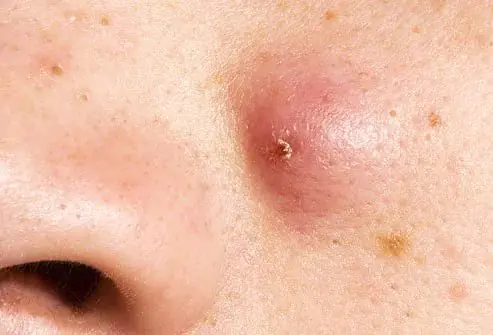
Another inhabitant of human skin is Staphylococcus aureus. When this microorganism penetrates the mouth of the hair follicle, a painful boil is formed - a boil.
Types of inflammatory elements
Acne on the face can be of several types:
- Comedones open and closed. Open comedones are the well-known blackheads; closed comedones, also called prosyanka, are white round-shaped compactions located under the skin.
- Papule. This element is a dense, hollow, red tubercle that rises above the skin. It does not form pus, and it may go away on its own within a few weeks or transform into a pustular element.
- Pustule. An inflammatory pimple with a cavity inside filled with pus. Tubercles. Such elements are formed in the last stages of the disease. They lie deep in the dermis and, as they develop, come to the surface of the skin, acquiring a spherical shape. The most severe form is considered to be spherical or conglobate acne, which affects not only the skin, but also fatty tissue.
- Cysts. Despite the traffic jams, the sebaceous glands work and secrete a secret that stretches the ducts and increases the glands themselves in volume and cysts form. They very often become inflamed with the formation of pus and turn into bluish deep nodules, called cystic acne.
With the evolution of any element of acne, as a rule, the abscess opens, the pus is rejected and a scar forms.
What can painful acne on the face mean?
Acne on the face is a signal that a malfunction has occurred in the body. Eastern medicine associates a specific area on the face with the condition of internal organs:
- on the lower jaw, under the chin - malfunction of the gastrointestinal tract, frequent constipation; painful subcutaneous pimples on the face in the temporal region - problems with the liver and bile ducts;
- acne running in a vertical stripe on the cheeks - the likelihood of kidney pathologies;
- Pimples under the cheekbones in women signal malfunctions of the mammary glands.
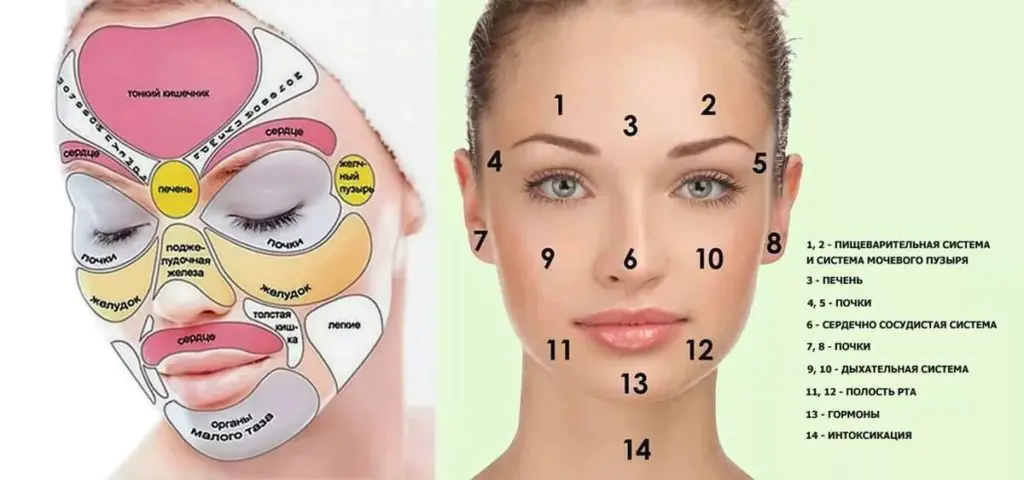
Naturally, this is only an assumption by oriental doctors and is absolutely no reason to establish a conclusion based on the location of acne and begin treatment of internal diseases.
Acne classification and symptoms
Painful acne can occur at any age. Acne of newborns, adolescents and adults is classified separately. Acne is also divided according to the severity of the disease, the most painful of which are nodular and conglobate acne.
Newborns often develop small pimples, which are closed and open comedones. They do not cause discomfort to infants and self-destruct within two weeks without requiring treatment.
Acne appears extremely rarely in childhood, and if it does appear, it usually occurs in children with adrenal dysfunction, so consultation with an endocrinologist is necessary. Such formations are rarely comedones. More often these are inflammatory and painful elements. The danger of such acne is that it can recur in adulthood and in a much more severe form.
In youth, acne on the face forms primarily in the T-zone (nose, chin, forehead). In most cases, juvenile acne consists of open and closed comedones, but in 20% of cases, acne causes serious physical suffering and is very painful. This form of acne requires medication under medical supervision.
During puberty, deep inflammatory elements, both single and multiple, can occur. They can merge with each other and form a large, painful abscess, which leaves behind scarring changes in the skin. Such acne is called conglobate acne.
Late acne that occurs in adulthood may be a consequence of juvenile acne or a separate disease caused by one or more of the factors described above.
Diagnostics
As a rule, it is enough for a dermatologist to examine the patient to make a diagnosis. Depending on the number and type of inflammatory elements, additional studies are prescribed to determine the cause.
In severe forms of the act that require treatment with antibacterial drugs, purulent contents are collected to determine the sensitivity of microorganisms to the active components of antibiotics.
General principles of treatment
Acne requires long-term and painstaking treatment, which must solve several problems at once:
- skin care and strengthening the immune system to prevent the recurrence of acne;
- elimination of existing spots, scars, stagnant spots;
- elimination of the inflammatory process; normalization of the secretion of the sebaceous glands.
Treatment of acne is carried out using local and systemic drugs, while in parallel with acne therapy, treatment of concomitant diseases is carried out. If acne is painful and inflamed, hardware techniques are not used. They have proven themselves well at the comedonal stage.
There is a high probability that you will need to undergo examination by other doctors: a gynecologist, an endocrinologist, a gastroenterologist.
The doctor determines the treatment method and medications individually. The choice depends on the severity of the disease, the cause of its occurrence, the age and gender of the patient.
Internally diseased acne takes an average of 6 to 8 months to treat using a comprehensive approach.
Treatment with local medications
If mild to moderate acne is diagnosed, treatment is possible exclusively with local medications. It will be long-term (at least 3 months), but effective.
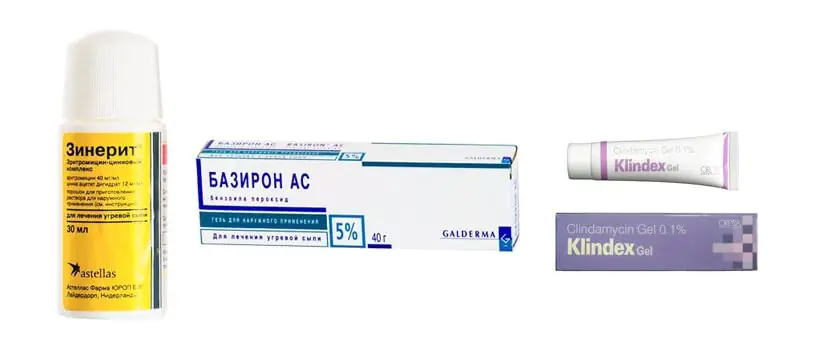
Products based on azelaic acid (Skinoren), benzoyl peroxide (Baziron AS) and retinoids (Roaccutane) are mainly used. The drugs reduce the secretion of the sebaceous glands, normalize the process of keratinization of epidermal cells and eliminate inflammatory processes.
Local antibiotics are prescribed together with them. They are not used separately as they are effective only against one element in the development of acne – bacteria. The most effective are erythromycin (Zinerit) and clindamycin (Clindamycin).
Curiosin, the main active ingredients of which are hyaluronic acid and zinc, is used to prevent the appearance of scars.
To stop acne from hurting too much, you can try applying Ichthyol ointment at night. It has anti-inflammatory, bactericidal and analgesic effects. User reviews confirm the great effectiveness of ichthyol against painful acne.
Preparations for oral administration
In the presence of severe forms of acne (cystic acne, conglobate acne, papulopustular rashes), retinoids are used:
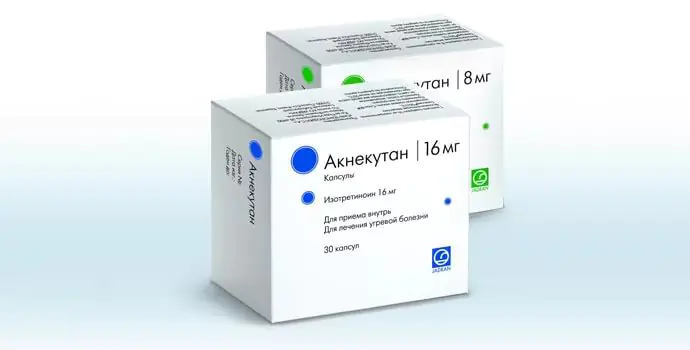
The active substances of these drugs reduce sebum production, relieve inflammation and affect the process of keratinization at the mouths of hair follicles. Treatment with retinoids is long-term and lasts up to 8 months. Their use must be under the constant supervision of a doctor, which is due to a large number of contraindications and side effects.
In some cases, antibiotics may be prescribed for acne. Of the systemic antibacterial medications, erythromycin and tetracycline are most often prescribed in combination with probiotics to prevent dysbiosis. Probiotics can also help relieve painful acne, as they have a beneficial effect on the gut and help boost immunity.
If the appearance of painful acne in women is associated with hormonal disorders, hormonal contraceptives are prescribed, such as Diane 35. The active substances of the drug reduce the secretion of the sebaceous glands by suppressing the activity of androgens.
Traditional methods of treatment
Traditional medicine can be used as an additional treatment for painful rashes. If a pimple hurts and there is severe redness, it is recommended to apply an aloe leaf to the inflamed area overnight. By morning, the pain will subside and the redness will become noticeably less.
As an auxiliary therapy, rubbing inflamed rashes with herbal decoctions is encouraged. Chamomile has a good calming, antiseptic and anti-inflammatory effect. The plant can also be used as a lotion.
Forecasts
Treatment of acne is a long process and it must be completed without taking breaks. A noticeable improvement in the condition at the beginning of therapy cannot serve as a reason to complete the course. The danger of acne is that at any moment the disease can arise in a more acute form than before.
Since acne is a chronic disease, it is important to know the causes of exacerbation and learn how to stop them in time. This will help avoid the formation of cosmetic skin defects (red, rough scars and stagnant spots). Unfortunately, if subcutaneous acne has already appeared, then irreversible processes begin in the epidermis and dermis and it will not be possible to return the skin to its previous ideal state.
Nevertheless, the drugs and techniques existing today are able to significantly alleviate the course of acne, prevent relapses and significantly reduce periods of remission.
Our appearance and mood clearly indicate not only our mood, but also our state of health. Chinese doctors carry out a full diagnosis and find out the result only after an initial examination, paying attention to such specific things as skin tone, iris color, voice timbre, and smell. An ordinary person without specialized knowledge is also able to identify some ailments only by appearance, by rashes on the face and their location.
What is the connection between acne on the face and internal organs?
Rashes are not the most pleasant thing. Therefore, as soon as they appear, we think about what to do with acne on our face. Trying to get rid of them using mechanical and cosmetic means, few people think that these could be signals from the body about the state of our health. Their localization can directly indicate problems with certain organs. This diagnostic technique is not know-how and has a centuries-old history. Doctors do not deny the fact of the relationship between acne and disease, although they avoid this method in professional treatment.
How to determine organ disease by facial skin
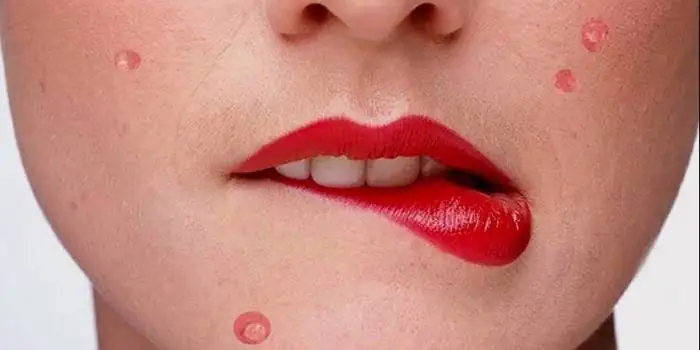
The appearance of rashes above the eyebrows or under the eyes is not accidental, especially if it occurs periodically. What organs are responsible for acne on the face? Each site corresponds to a specific organ. The formation of pigment spots and redness also signals problems and the presence of ailments. Therefore, before getting rid of acne, you should determine the cause of its appearance. Perhaps the cosmetologist is powerless here. A correct diagnosis and therapy will help cure the existing disease, and as a result, acne.
The meaning of acne on the face by zone
What do pimples on the forehead or above the lip mean? Pay attention to where your acne is located. Perhaps it is the chin or the bridge of the nose. If these rashes appear periodically or are even permanent, it is worth checking the condition of the organs associated with this area of the face. It is unlikely that one pimple that appears once in any area indicates the presence of an incurable disease. At the same time, do not underestimate the signals that our body sends to us. A map of the relationship between areas of the face and organs (photo below) will help you see this relationship.
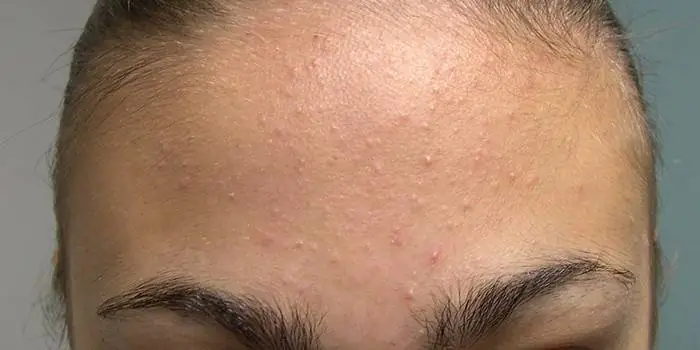
When considering this area, it is worth highlighting several zones. If there are pimples on the forehead, which organ is affected will help determine their location. A location close to hair growth signals gallbladder disease. The eyebrow area is connected to the intestines. Pimples that appear here indicate irritation and interruptions in the functioning of this organ. The forehead contains a large number of sweat glands, and acne is not uncommon here. This entire area is associated with digestion and the functioning of the gastrointestinal tract, so it would not be a bad idea to visit a gastroenterologist.
This small area of the face, located between the eyebrows, is also “responsible” for its organ. Pimples located in this area clearly indicate problems with the liver. A common cause is poor diet, consumption of alcohol and fatty foods. Harmless products such as milk and cream, consumed in excessive quantities, cause liver problems. The recommendations in this case are simple: give up alcohol, watch your diet, and include exercise in your daily routine.
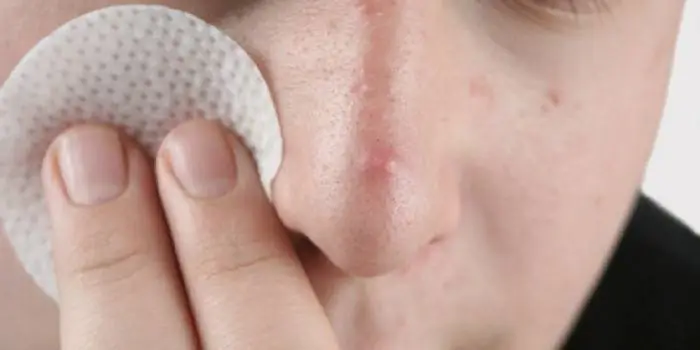
Diagnosis of diseases based on acne on the nose is difficult. They can be caused by various reasons. During periods of hormonal changes, rashes are a common occurrence. Transitional age, pregnancy, menstruation are periods during which the appearance of acne cannot be clearly interpreted. What organs are responsible for acne on the face in the nose area? This is the engine of our body - the heart. Check your blood vessels and cholesterol levels. Acne will allow you to recognize more serious problems in time.
The appearance of acne here indicates kidney disease. A nephrologist treats the kidneys. Initially, you should contact a therapist who is able to recognize the disease and, if necessary, refer you to a specialist. General recommendations include: following a diet, drinking plenty of water (this should be purified still water). If no serious problems are identified, then contact a cosmetologist.
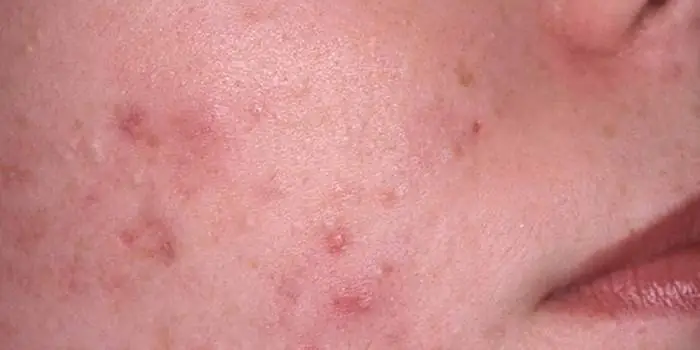
In this area, there are 2 sections responsible for different organs. Pimples located on the cheeks (closer to the eyes) are “tied” to the stomach. A little lower is the area associated with our lungs. It has been repeatedly noted that pimples on the cheeks appear more often in smokers. People with allergies are also at risk. If acne appears, get a fluorography, stop smoking, and check your intestines. The sun and excessive sweating can cause acne, so be sure to protect your skin before going out in the sun.
Which organ is responsible for acne on the face around the eyes? This area, in its connection to the internal organs, is similar to the ears and correlates with the kidneys. It is worth taking into account not only the presence of acne, but also redness, swelling and dark circles. Papillomas indicate a high probability of the presence of cysts and congestion. Fatty plaques indicate the formation of kidney stones.
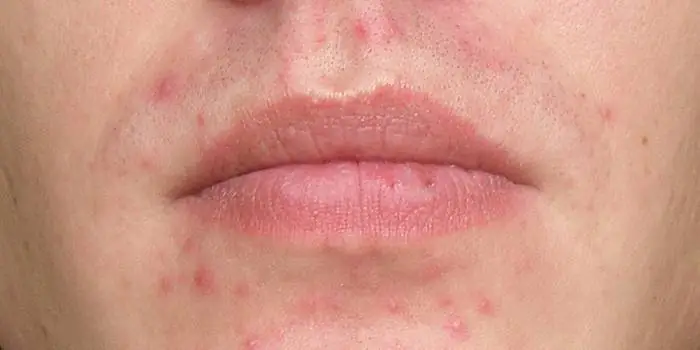
The appearance of rashes here is associated with the functioning of the nervous system. It may be worth paying attention to the time allotted to sleep and eliminating stressful situations. This will help not only find the answer to the pressing question - what helps with acne on the face, but also significantly improve your overall condition. Our heart can talk about its problems through the appearance of pimples on the upper lip. This area is still capable of signaling hormonal instability. Frequently touching and near your lips with dirty hands contributes to the formation of rashes.
For women, such acne is a serious reason to consult a gynecologist, as it indicates problems in the pelvic area. For men, these are potential prostate problems. Diseases of the digestive system are very often reflected in the form of acne in the chin area. In this case, enrich your diet with more fiber and drink herbal teas.
Video: what they are talking about and how to cure acne on the face
The process of acne formation and the reasons for their appearance are discussed in detail in the video. Qualified specialists will talk in clear language about the technique of diagnosing diseases based on rashes and how to get rid of acne on the face safely and effectively. The information presented in the video contains specific advice and names of medications recommended by experts.



